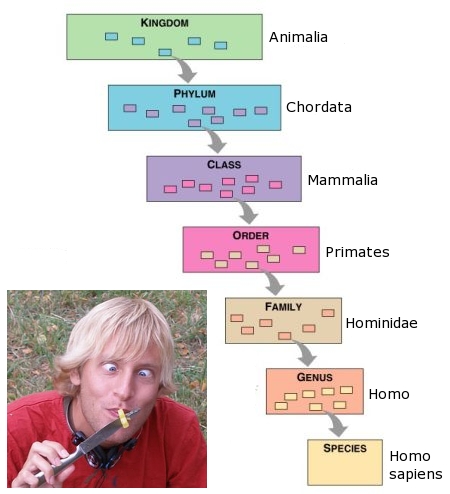Taxonomic Dictionary

mutation: any event that
changes genetic structure.
taxon: a particular group of
organisms of any taxonomic rank, e.g. a phylum, a genus, or a
species.
taxonomy: the science of finding, describing and categorising
organisms.
sister group: the two clades resulting from the splitting of a single
lineage are called sister groups.
anagenesis: evolutionary
change of characteristics within a line without an increase in the
number of groups.
cladogenesis: branching of lineages during phylogeny.
clade: a group of biological taxa or species that share features
inherited from a common ancestor.
homology: any similarity
between characters that is due to their shared ancestry.
analogy: two structures that perform the same or similar function by a
similar mechanism but evolved separately.
homoplasy: a correspondence between the parts or organs of different
species acquired as the result of parallel evolution or convergence.
apomorphy: any feature novel to a
species and its descendants.
synapomorphy: an apomorphy shared by two or more species or clades.
plesiomorphy: a character state that is present in both outgroups and
in the ancestors.
monophyly: a group that includes
an ancestral species and all its descendants.
paraphyly: excluding some descendants of the common ancestor.
polyphyly: convergent evolution describes the acquisition of the same
biological trait in unrelated lineages.
phylogeny: the evolutionary
history of an organism.
ontogeny: refers to the history of an organism from birth.
cladogram: a branching treelike graphical representation of the
phylogenetic relationships between organisms showing which species have
branched from common ancestors.
phylogram: differs from a cladogram in that the branches are drawn
proportional to the amount of inferred character change.
holotype: the single physical
example (or illustration) of an organism, known to be used when the
taxon was formally described.
paratype: a specimen of an organism that is used as the basis of a
taxonomic description.
allotype: a specimen that exemplifies the opposite sex of the holotype.
syntype: any of two or more specimens listed in a species
description where a holotype was not designated.
neotype: a specimen later selected to serve as the single type specimen
when an original holotype has been lost or destroyed, or where the
original author never cited a specimen.
lectotype: a specimen later selected to serve as the single type
specimen for species originally described from a set of syntypes.
